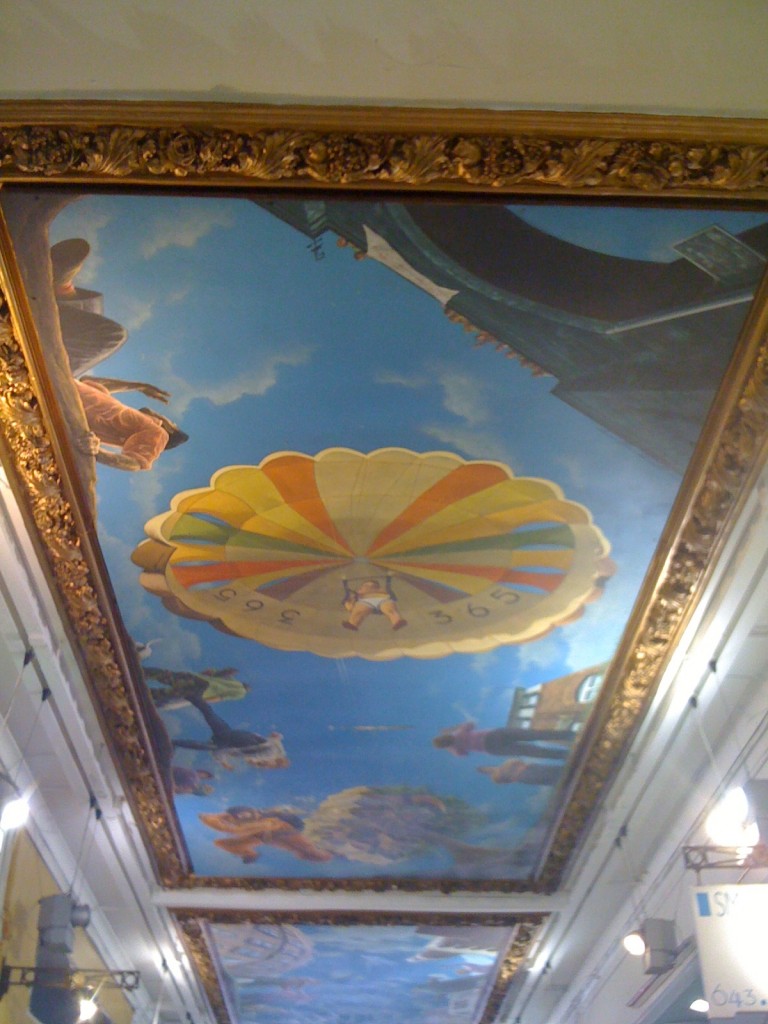Piccadilly Arcade – Part II
My passage through the Piccadilly Arcade is generally conducted at such a brisk pace as I dash to and from the station, my feet going at the pace of an egg whisk and my attention directed to such lofty thoughts such as ‘did I unplug my hair straightners?’, that I am largely oblivious to my surroundings. Goodness knows how many times I raced through the Arcade before I happened to look up and notice, with a jolt of surprise, the drama being played out above my head. For the ceiling of the Piccadilly Arcade comprises a series of five huge panels and one smaller one, each of which seems to be depicting a different stage in an unfolding story involving a man and a parachute. It was painted by a contemporay artist called Paul Maxfield and is entitled ‘A Life In The Year Of The Chinchillas’. For me, what’s striking about the panels is the way in which they make me feel as if I am looking up at the action and could, with the aid of a ladder, climb up and join in. The illusion of reality is so real that when I craned my neck to look at the middle panel, which shows the man about to land with his parachute fully opened, it almost felt as he might land on my head.
Even on my first sighting, the ceiling of the Piccadilly Arcade seemed strangely familiar and I was convinced that I had seen something similar in a book about art history. And sure enough, a quick flick through my books confirmed that I was right. For there was indeed a Venetian called Andrea Mantegna, working during the Renaissance period about 600 years ago, who is credited as being the first artist to paint objects and people onto ceilings so convincingly that they appear to be three dimensional. A really good example of Mantegna’s work, and the one that reminds me of the Piccadilly Arcade, is the ceiling of a bridal chamber that Mantegna decorated between 1465-74 for the Gonzaga family.
I already knew that being able to create the optical illusion of reality from a flat surface in this way is known as ‘trompe l’oeil which is French for ‘trick of the eye’. It wasn’t until I consulted my invaluable ‘. . . isms Understanding Art’ by Stephen Little, however, that I discovered that there is a very specific Italian phrase used to refer to the illusionary ceiling paintings of Mantegna and those who followed in his artistic footsteps. The phrase is ‘di sotto in su’ which translates as ‘from below upwards’. The success of this type of illusion depends upon the skill of the artist to understand and manipulate perspective by shortening figures so that the illusion of depth is given. It is technique known as foreshortening.
I suppose that to our 21st Century eyes, so accustomed to the amazing visual trickery produced by the wonders of technology, Mantegna’s ceiling doesn’t have a huge impact. But it would have been a very different story in Mantagna’s day because prior to the Renaissance, paintings tended to be flat and two-dimensional. It wasn’t until Leonardo da Vinci and his contemporaries worked out the rules of perspective that artists were able to master the art of illusion and use it to create almost theatrical effects which had the potential to evoke emotion and stir the soul. How fitting therefore that Maxfield chose to use this sort of technique to decorate the Piccadilly Arcade – once home to a very modern method of stirring the soul – and one with which we are all familiar – the cinema.





Piccadilly Arcade, Birmingham, Part I « Birmingham Conservation Trust July 28, 2011
[…] Click here for Part II of the series […]
Piccadilly Arcade – Part III « Birmingham Conservation Trust July 28, 2011
[…] blog is wondering why I am writing about the Piccadilly Arcade for the third time (see Part I and Part II ) I should perhaps explain that my office window looks out over the Arcade’s entrance on to […]
The painting still looks great after all these years. I’m the girl in the red polka dress with my daughter. We had photos taken on the kitchen roof for the artist to get the right angle. My daughter is now 26 years old.
I think this is fabulous painting, no matter modern technology. When you consider the skill which went into this.
By the way, as a currently ex-pat Brummie, who has partly defected to the East Midlands, I love this blog! Keeps me in touch with home.